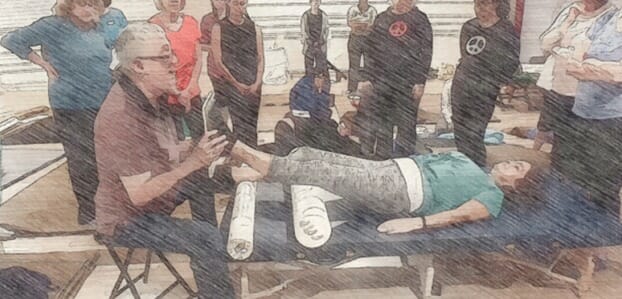
Making the best of a sad situation

Next Wednesday, I was supposed to start teaching a group of colleagues in Munich. Before the pandemic, we got together every six months for the next installment in MASTERING THE METHOD, an ongoing postgraduate course about the art and science of Functional Integration.
Each time we meet, I walk them through a classic Functional Integration® lesson step-by-step over five days. I slowly and methodically teach one lesson’s fundamental moves, showing what to look for and how to make sense of what you see, and revealing the subtle ways of sensing the difference that makes a difference. This format allows for ample time to practice, make incremental progress, and grasp the overview of the lesson by building up an understanding of what holds the details together.
Next week’s module, the first of a three-part WALKING WELL project, teaches how to make use of one of Feldenkrais’ ingenious inventions, called THE ARTIFICIAL FLOOR.
That evening, during the Amherst Training (the last teacher training program Dr. Feldenkrais gave), when my mentor, Edna Rossenas, walked a handful of my fellow trainees and me through this hands-on lesson, also known as the footboard, still stands out in my memory.
We gathered in the living room around the Feldenkrais table. Someone volunteered, lying supine on the table. Edna began touching the bottom of my classmate’s foot with the small wood cutting board we’d borrowed from the kitchen. Gradually and progressively introduced us to how the surface can simulate standing on the floor, explore the mobility of the foot and leg, and evoke the whole-body coordination of standing.
With equal measures of patience and fascination, she showed us how, exactly, to hold and move the board. Demonstrating where and how to touch the toes and foot, she revealed when to move and when to wait, pointing out what to watch for and how to interpret it. By doing this, Edna made explicit the journey the lesson can take, pointing out the guideposts along the way, and illuminating its potential.
This FI lesson has been part of my repertoire ever since Edna’s introduction. Just the other day, the student I had just given the lesson marveled at the changes it brought about.
Postponing the Munich module left me feeling blue. I have been looking forward to passing on what I learned about the footboard back then from Edna, from other trainers, and in my practice over the intervening decades. I was sitting around, sulking and feeling sorry for myself, when I read one of the responses to “Not leaving on a jet plane,” my blog about the workshop not happening.
My friend and colleague(and co-editor of The Feldenkrais Method: Learning Through Movement), Chrish Kresge, wrote:
“I’m sure you’ll find a way to make some sweet lemonade from these sour lemons.”
Reading that popped me out of my sullen state.
What a good idea. Once I stopped feeling sorry for myself, I began to think about this lesson and the purpose of teaching it: making this knowledge available to my colleagues and contributing to the development of what we have to offer our students.
 Last year, I made the recordings of the five-day teacher training segment I taught in Baltimore about THE ARTIFICIAL FLOOR available to Feldenkrais teachers and trainees. It seemed like the perfect pandemic lesson with the teacher sitting at the end of the table farthest from a student’s head and not needing to touch them directly.
Last year, I made the recordings of the five-day teacher training segment I taught in Baltimore about THE ARTIFICIAL FLOOR available to Feldenkrais teachers and trainees. It seemed like the perfect pandemic lesson with the teacher sitting at the end of the table farthest from a student’s head and not needing to touch them directly.
Because of the hardships created by lockdown, we offered this product, called MAKING THE CONNECTION, on a choose your price basis.
Almost exactly a year ago, on the last weekend of November 2020, I was set to teach the MASTERING THE METHOD floorboard module at the Feldenkrais Institute of Vienna. That was not to happen.
Not in person, anyway.
We moved the course online. I was excited to unpack the inner workings of this classic composition, explain when and how to teach this lesson, and show what we can learn from it. My online teaching experience, recently and over the years, prepared me well for reimagining the curriculum. It took some time, but I found ways to address the most challenging aspects — how to convey the delicate interplay of forces and develop the requisite coordinated self-use from afar.
Since no one had to travel to attend, we added to half-day follow-up sessions a couple of months after the five days of the module. These meetings gave us time to review the material, made it possible to respond to the questions that had arisen, and gave the participants an unprecedented opportunity to refine their understanding and skill.
Even though I can’t teach the course live in a week, why not make these 20+ hours of video and audio recordings as well?
It seemed like such an excellent idea. I couldn’t think of a reason not to do it. So, we added the Vienna files MAKING THE CONNECTION, tripling the included materials.

(In keeping with Mind in Motion’s aim to spread the knowledge about and use of this lesson, I made the recordings available to everyone who bought the original package. I didn’t charge anything extra, though folks are welcome to contribute something for the additional materials if they felt so moved.)
If you’re ready to:
- Learn the essential moves.
- Tap into the foot’s influence on the whole body.
- Improve your hands-on skills, self-use, and teaching acumen.
- Become a better Functional Integrator.
. . . the entire program is now available to Feldenkrais colleagues on a pay what you choose basis. You can find out more here.
Your thoughts?
Please let us know your perspective! Add your comments, reactions, suggestions, ideas, etc., by first logging in to your Mind in Motion account and then clicking here.
Commenting is only available to the Mind in Motion Online community.
Join in by getting your free account, which gives you access to the e-book edition of Articulating Changes (Larry's now-classic Master's thesis), ATM® lessons, and more — all at no charge whatsoever.
To find out more and sign up, please click here.
Please share this blog post
 This work is licensed under a Creative Commons Attribution-ShareAlike 4.0 International License
This work is licensed under a Creative Commons Attribution-ShareAlike 4.0 International License
This blog may contain one or more affiliate links. When you click on a link and then make a purchase, Mind in Motion receives a payment. Please note that we only link to products we believe in and services that we support. You can learn more about how affiliate links work and why we use them here


Your generosity is always inspirational and appreciated. Happy Thanksgiving. Rivkah
Thank you kindly, Rivkah.
Happy Holidays!